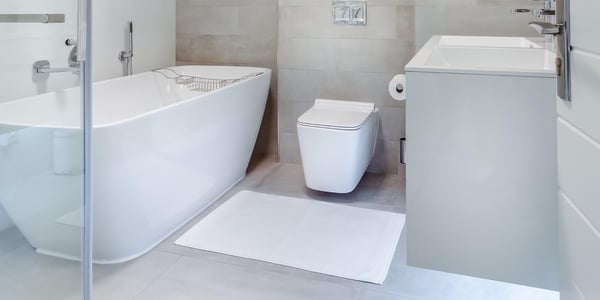Many of the injuries that occur every day happen in the home. Of these, a large portion occurs in...
Walk-in Tubs vs. Walk-in Showers: Pros and Cons
Recent studies have highlighted a concerning statistic: approximately 80% of fall injuries among older adults take place within the confines of their own homes, specifically in the bathroom. This alarming fact underscores the importance of taking necessary precautions and creating a safe environment for seniors within their homes. When it comes to ensuring bathroom safety, a crucial decision is deciding between a walk-in tub vs. shower.
In this article, we will explore the advantages and disadvantages of each option, equipping you with the knowledge needed to make an informed and appropriate choice.
Walk-In Tub Pros
A walk-in tub is a little deeper than the standard tub. There is generally a seat in the tub on one side, and one wall will function as a door. Many walk-in tubs also come with hydrotherapy jets.
Here are some of the top benefits for older adults if they opt for a walk-in tub:
-
Low Threshold
One of the best benefits of a walk-in tub is that they have a low threshold. This means they come with swing-in or swing-out doors that let a person enter. Because of this, there is no need to climb high to enter the tub.
-
Lower Risk of Slips
The walk-in tub floors are usually made with a slip-resistant material. Such a material lowers the risk of falling and slipping inside the tub. So, going in and coming out will be much less risky.
-
Full Immersion
Walk-in tubs have a built-in seat, meaning the person bathing can sit on it and become submerged in the water. They can do this without sitting all the way down or bending in the tub. One can sit down and shower without worrying as much about falling or slipping.
-
Ease of Maintenance
Finally, walk-in tubs are typically easy to clean, as you only need a nonabrasive cleaner to begin cleaning. Some also have a self-sanitizing system for easy cleaning, so you won't have to worry about this while maintaining the cleanliness of the bathroom.
The Cons of a Walk-In Tub
Now that you are familiar with the pros of a walk-in tub, there are some downsides. These include:
-
Time to Drain
If there is a medical emergency, the person will have to wait for the water to drain before getting help. This will not be an issue if the tub has a built-in call button or a rapid draining feature.
-
Flood Risk
There is a risk of flooding or leak if a seal failure happens.
-
Assistance
It can be challenging for the person to assist another in this tub while they bathe.
These are the top three cons of a walk-in tub. Compare them to the pros to decide if it is the right choice for your home's seniors.
The Pros of a Walk-In Shower
Here are some of the top benefits of a walk-in shower for seniors:
-
You Can Add Safety Features
You can pay extra for the shower and add safety features for seniors. These include grab bars, nonslip flooring, anti-scald valves, etc. All of this will allow the senior to be safe and sound inside the shower.
-
Easier To Clean
The walk-in shower is much easier to clean than other options. There are fewer surfaces where dirt and water can collect, so you won't have to kneel or bend as much to clean it.
-
Less Space
As a general rule of thumb, a walk-in shower takes up less square footage than a walk-in tub. This is ideal if you have a smaller bathroom.
-
Accommodating People With Wheeled Mobility
One of the top benefits of the walk-in shower is that it can be designed to accommodate people with wheeled mobility. However, these showers will be much bigger than the traditional ones. So, if you have a senior at home that utilizes support or a wheelchair, this can be an excellent choice for them.
-
Available In Various Designs
Finally, walk-in showers come in many designs. Various styles will easily suit your bathroom and home, so if you care about aesthetics, this can be a good choice.
The Cons of a Walk-In Shower
Here are some of the top cons you might experience with a walk-in shower:
-
Safety Installations
You will have to install additional safety features, which are much more expensive.
-
Movement
Showering requires a lot of movement, which is why it might not be ideal for people with restricted mobility or problems such as vertigo.
-
Space Requirements
You need resources and a large space to make the shower work and remain safe for the seniors in your home.
When it comes to prioritizing the safety and well-being of older adults in their homes, the bathroom emerges as a critical area to address. With the majority of fall injuries occurring within this space, it becomes imperative to implement preventive measures that mitigate the risks and provide a secure environment. The decision between a walk-in tub and a walk-in shower plays a crucial role in achieving this objective.
Ultimately, the decision should be based on factors such as mobility limitations, personal preferences, and budget considerations.
Regardless of the chosen option, the overarching goal remains the same: to create a safe and comfortable bathroom environment that enables older adults to maintain their independence and confidence. It is advisable to consult with professionals or seek advice from healthcare providers to ensure that the chosen solution meets all necessary safety standards.
Let us know in the comments below - Which do you prefer? Why?






